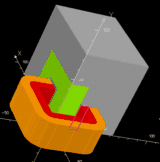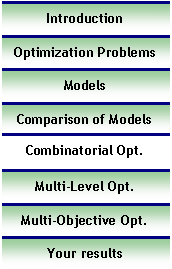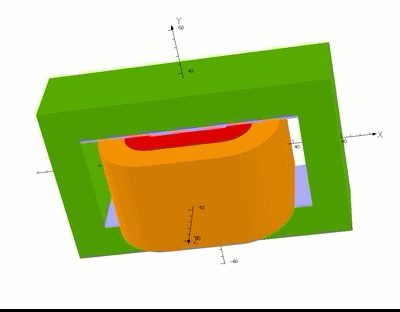Four combinatorial optimization methods are examined. The first one, a commercial software, Pro@Design is based on reducing spaces of discrete variables. The second one is Exhaustive Enumeration (EE) method solved by Matlab® distributed computing toolbox. This simplest method assures the global solution with a huge computational time. The third one is a stochastic method, Genetic Algorithm based on Darwin theory of evolution. The fourth one is Branch-and-Bound method that obtains the same global solution as EE method with a smallest CPU time. The continuous optimization using SQP is also performed and taken as reference.
Table II shows numerical results and computational time of these combinatorial optimization methods. Clicking on the name of the method, a description of the method appears with the authors name and associated references.
Table II
- Results of the Combinatorial Optimization with EE, GA, BB
Parameters |
Continuous optimization |
Combinatorial optimizations |
ProDesign |
|
|
|
a |
mm |
12.92 |
18 |
18 |
18 |
18 |
b |
mm |
50.12 |
54 |
54 |
54 |
54 |
c |
mm |
16.61 |
18 |
18 |
18 |
18 |
d |
mm |
43.26 |
33.5 |
33.5 |
33.5 |
33.5 |
S1 |
mm2 |
0.325 |
0.3318 |
0.2827 |
0.2376 |
0.2827 |
S2 |
mm2 |
2.912 |
2.835 |
2.27 |
2.835 |
2.27 |
n1 |
- |
640.77 |
722 |
610 |
614 |
611 |
Mtot |
kg |
2.311 |
2.840 |
2.594 |
2.633 |
2.594 |
Time, t |
s |
4 |
38 |
14*106 |
3*103 |
816 |
Tco |
°C |
108.80 |
103.60 |
109.20 |
106.25 |
109.20 |
Tir |
°C |
100.00 |
94.19 |
99.58 |
97.13 |
99.58 |
η |
% |
89.55 |
88.54 |
87.60 |
88.04 |
87.60 |
Iμ /I1 |
% |
10.00 |
4.90 |
9.98 |
9.58 |
9.98 |
DV2 /V2 |
% |
6.91 |
8.20 |
8.20 |
7.86 |
8.20 |
f1 |
% |
50.00 |
49.29 |
35.50 |
30.20 |
35.50 |
f2 |
% |
50.00 |
47.56 |
32.20 |
37.98 |
32.20 |










